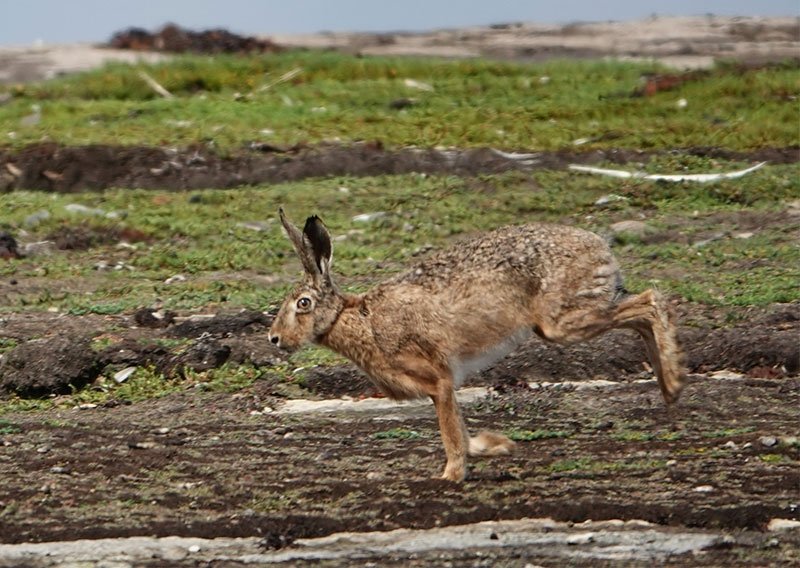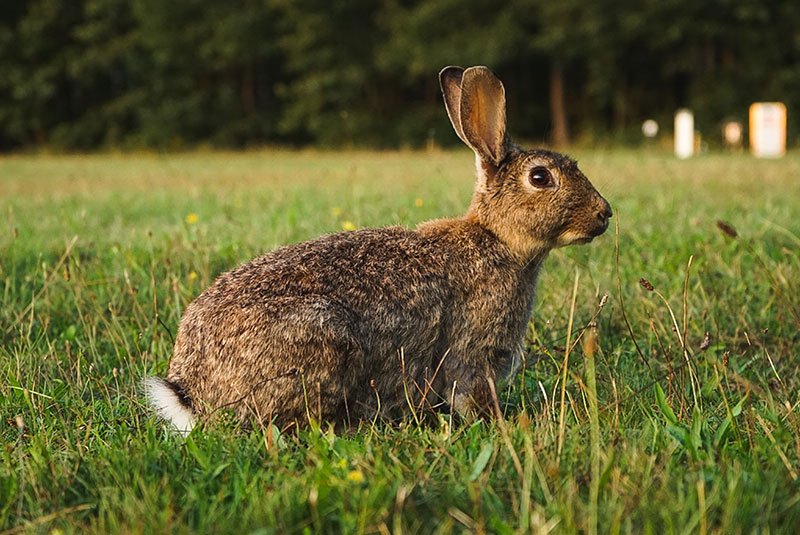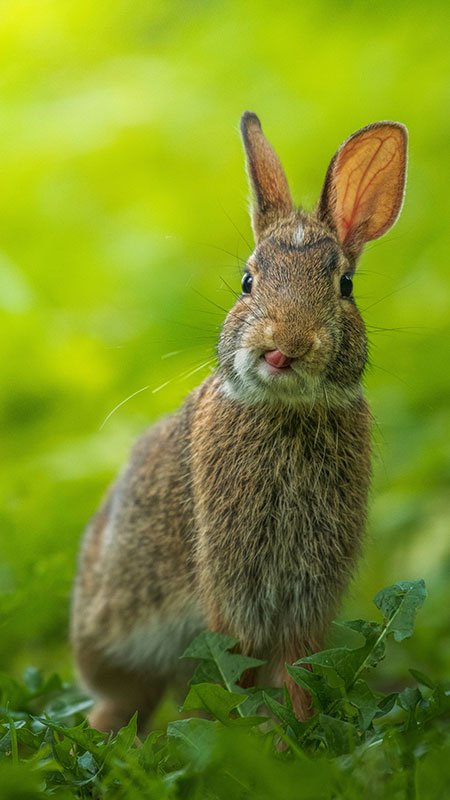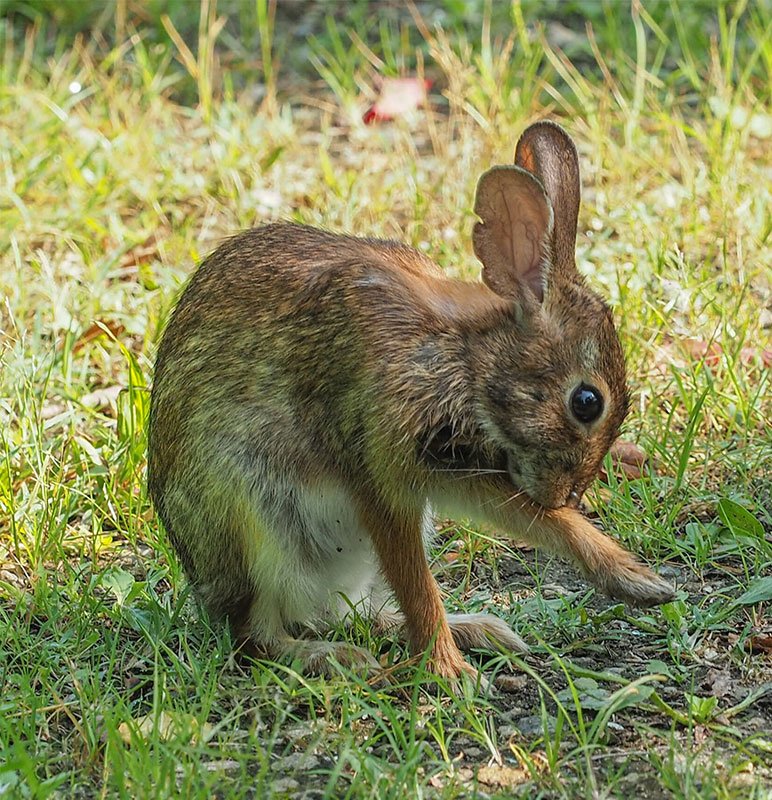Ear-Resistible
Photo by Aswathy N on Unsplash
Leporidae
by Inspector Barry Mins on January 9, 2024Hey kids, welcome back to our series on the mysteries of created kinds.
We took a few weeks off for Christmas (I hope everyone had a great one!), but we are back now and moving on to our next kind. Last time, we met a small hopping marsupial. This week, we move from marsupials to placental mammals, but they are still best known for their hopping.

This kind has a very wide range, being found on every continent except Antarctica and in almost every climate, from tropical forests1 to open grassland2 to the Arctic north.3 Some species like to live near water4 and even take baths.5 Many species like to burrow, with some even burrowing in the snow!
The members of this kind are herbivores, feeding on plants. Grasses tend to be preferred, but they will eat most other forms of plants.6 When available, they will happily munch on farmer’s crops too.7 Some species are also comfortable in suburban and even urban settings. When I was a child, we had one raise her babies in a hole under our patio! She would even bring them out to eat where we could watch from the window!
Speaking of babies, this kind is known for multiplying quickly. They have roughly three babies per litter, and the babies are weaned after just three weeks.8 They mate at a mere five months of age.9 That means that, in ideal positions, their populations can explode in a very short time. They were introduced to Australia in 1788, and by the mid-1820s, their population had exploded. In one area, millions could be killed annually with no dent made in the population.
Has anyone figured it out yet? This week’s kind is the Leporidae—the rabbit kind. Stay tuned for next week when we’ll stay in Australia and look on tree trunks for a kind of insectivorous bird.
Try out this fun crossword!
Clue
Your clue for the week is:
This kind is found only in Australia and New Guinea and enjoys pulling arthropods from trees.
Ask a Question
Have you ever had a question about created kinds but didn’t know who to ask? Have you ever wanted to learn more about your favorite kind? Well, now you can! You can ask me, Inspector Barry Mins, a question! Have your parents help you fill out this form, and you might get your question answered in my column! If you have any questions about created kinds, feel free to send them my way!
Footnotes
- Andrew Tilker, An Nguyen, Duy Le, Huong Van Le, Son Van Le, Truong Hong Luu, Bang Van Tran, and Andreas Wilting, “New Records and Southern Range Extension of the Annamite Striped Rabbit Nesolagus timminsi in Vietnam,” Mammalia 85, no. 5 (May 2021): 417–421, https://www.researchgate.net/profile/Andrew-Tilker/publication/351603222_New_records_and_southern_range_extension_of_the_Annamite_striped_rabbit_Nesolagus_timminsi_in_Vietnam/links/6141eb6227dcdd633a514b85/New-records-and-southern-range-extension-of-the-Annamite-striped-rabbit-Nesolagus-timminsi-in-Vietnam.pdf?_sg%5B0%5D=started_experiment_milestone&origin=journalDetail&_rtd=e30%3D.
- Wim Wendelen and D. C. D. Happold, “The Distribution of Poelagus marjorita (Lagomorpha: Leporidae) in Central Africa,” Mammalian Biology 71, no. 6 (2006): 377–383, https://www.researchgate.net/profile/David-Happold/publication/248907687_The_distribution_of_Poelagus_marjorita_Lagomorpha_Leporidae_in_central_Africa/links/59f7f897458515547c24d833/The-distribution-of-Poelagus-marjorita-Lagomorpha-Leporidae-in-central-Africa.pdf.
- David R. Gray, “Behavioural Adaptations to Arctic Winter: Shelter Seeking by Artic Hare (Lepus articus),” Arctic 46, no. 4 (December 1993): 340–353, https://www.jstor.org/stable/40511436.
- Ken Sugimura, Shiegho Sato, Fumio Yamada, Shintaro Abe, Hirofumi Hisakawa, and Yukari Handa, “Distribution and Abundance of the Amami Rabbit Pentalagus furnessi in the Amami and Tokuno Islands, Japan,” Oryx 34, no. 3 (July 2000): 198–206, Google Scholar.
- Alexei V. Abramov, Alexei N. Tikhonov, and Nikolai L. Orlov, “Recent Record of Annamite Striped Rabbit Nesolagus timminsi (Mammalia, Leporidae) from Vietnam,” Russian Journal of Theriology 15, no. 2 (2016): 171–174, https://www.kmkjournals.com/upload/PDF/RJT/15/ther15_2_171_174.pdf.
- Fernando A. Cervantes and Jesus Martinez, “Food Habits of the Rabbit Romerolagus diazi (Leporidae) in Central México,” Journal of Mammalogy 73, no. 4 (1992): 830–834, https://www.researchgate.net/profile/Fernando-Cervantes-3/publication/271802764_Food_Habits_of_the_Rabbit_Romerolagus_diazi_Leporidae_in_Central_Mexico/links/550afc5b0cf265693cef4590/Food-Habits-of-the-Rabbit-Romerolagus-diazi-Leporidae-in-Central-Mexico.pdf.
- Thomas Reichlin, Erich Klansek, and Klaus Hackländer, “Diet Selection by Hares (Lepus europaeus) in Arable Land and Its Implications for Habitat Management,” European Journal of Wildlife Research 52 (2006): 109–118, https://boris.unibe.ch/22548/1/Reichlin2006_Article_DietSelectionByHaresLepusEurop.pdf.
- Tetsuya Matsuzaki, Muneo Saito, and Masao Kamiya, “Breeding and Rearing of the Volcano Rabbit (Romerolagus diazi) in Captivity,” Experimental Animals 31, no. 3 (1982), 185–188, https://www.jstage.jst.go.jp/article/expanim1978/31/3/31_3_185/_pdf.
- Jürgen Hoth and Humberto Granados, “A Preliminary Report on the Breeding of the Volcano Rabbit Romerolagus diazi at the Chapultepec Zoo, Mexico City,” International Zoo Yearbook 26 (1987): 261–265, https://www.researchgate.net/profile/Juergen-Hoth-Von-Der-Meden/publication/229843031_A_preliminary_report_on_the_breeding_of_the_Volcano_rabbit_Romerolagus_diazi_at_the_Chapultepec_Zoo_Mexico_City_Informe_preliminar_sobre_la_reproduccion_del_conejo_de_los_volcanes_Romerolagus_diazi_en/links/5bc531f0a6fdcc03c788c4fe/A-preliminary-report-on-the-breeding-of-the-Volcano-rabbit-Romerolagus-diazi-at-the-Chapultepec-Zoo-Mexico-City-Informe-preliminar-sobre-la-reproduccion-del-conejo-de-los-volcanes-Romerolagus-diaz.pdf.
- © 2024 Answers in Genesis
- Privacy Policy
- Contact
- About





